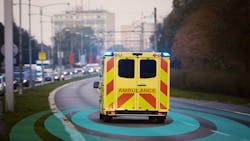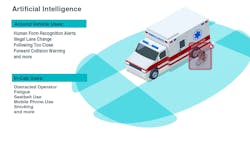According to the National Library of Medicine*, paramedicine clinicians in the US respond to 40 million calls for assistance every year. With the majority of these being time-critical, medical emergency services vehicles regularly travel at a considerably higher speed than surrounding traffic. Drivers must make split-second decisions to ensure they get to where they are needed safely and in the shortest possible time.
Working conditions for emergency services drivers
Ambulance drivers receive extensive training in high-speed driving which is designed to mitigate risks to themselves and to members of the public. However, even with intensive training, incidents can still happen, with transportation-related trauma being the leading cause of fatalities. There are an estimated 6,500 incidents involving ambulances every year.
Ambulances are frequently required to maneuver in space-restricted residential areas where turning and backing up can involve numerous vehicle blind spots, meaning drivers have to be particularly aware of vulnerable pedestrians and cyclists. In addition to these considerations, people who are working to help others are increasingly being threatened and even attacked while carrying out their duties.
This also applies to drivers of fire trucks which, because of their size and weight, are more likely to cause major injuries and fatalities if involved in a collision.
How vehicle safety solutions can help
So what can be done to support drivers of emergency vehicles to ensure they and those around them stay safe during emergency call outs?
One of the most practical and effective steps to take is to ensure that interior and exterior cameras and CCTV are installed in all emergency vehicles. Brigade’s dashcams and cameras are linked to a mobile digital recorder (MDR) which records activity around the vehicle. The telematics package connects hardware and software and includes real-time vehicle tracking, reporting and comprehensive data analytics. This footage provides invaluable evidence in the event of a disputed collision, or when the safety of emergency workers could be compromised – and it can also help prevent aggressive behavior.
SMART bbs-tek® back-up alarms can be a major contribution towards the safety of vulnerable pedestrians in the vicinity of an emergency call-out. An instantly locatable alarm sounds if a person steps into an ambulance’s blind spot; the sound is confined to the danger area and, unlike many other types of alarms, it continually adjusts to 5-10 decibels above the ambient noise, so it easily copes if noise levels fluctuate. For example, at the scene of a traffic incident or in a busy city street.
The AI revolution
Devices utilizing AI, such as Brigade’s Human Form Recognition HFR HD Backeye®360, are transforming emergency vehicle safety.
This 360° high-definition four-camera system uses AI to identify humans. Providing a comprehensive view of the surrounding area in a single image, HFR Backeye®360 audibly and visually alerts the driver when a person is detected, eliminating blind spots and actively saving lives. Fleet managers have the option of a single camera or a dual camera covering the rear and side for enhanced security.
The AI camera, which uses machine learning, is programmed to receive more information about the surroundings or situation prior to providing alerts or responses in the vehicle. Algorithms take the information they receive and learn from it, which means the safety benefits they provide are constantly improving. Whatever the situation, these cameras will alert drivers to situations such as a cyclist cutting across in front of the vehicle during an emergency call-out, or a pedestrian stepping into the road behind a vehicle that is backing up.
Driver safety cameras aim to reduce the possibility of an incident caused by driver fatigue or lack of concentration, and the recent introduction of artificial intelligence into these cameras has raised the specification considerably.
Sensors positioned near the steering wheel track signs of distracted behavior and tiredness by continuous monitoring of the driver’s face, eyes and head movements. They can also be utilized in patient bays for monitoring patients enroute as well as for added vehicle security.
Built-in AI analyzes these signals and provides audible alerts to the driver. Erratic steering and unusual vehicle positioning can also trigger an alarm, and there is also the option of alerting the fleet manager.
Corey Heniser, CEO of Brigade INC, said:
“Emergency workers risk their own lives daily to help others - protecting them so they can continue to do their critical and life-saving work is one of the most important things we can do in our business. Seconds count when it comes to emergency call outs and having the right safety devices fitted to a vehicle could be the difference between life and death, not only for those individuals who responders are trying to reach but the emergency workers themselves.”
About Brigade Electronics
Brigade Electronics provides emergency vehicle safety technologies, along with many more, to provide operators with the extra second or two they need to save lives. Its engineering team has designed these systems based on the environment, vehicle type, maneuverability, and work site conditions. The team is happy to assist in building the safety solution that best fits any needs and requirements. Learn more at brigade-inc.com.
Brigade will be attending EmsWorld Expo 2025 between 20th-24th October 2025 at the Indiana Convention Center and Luca Oil Stadium, 100 South Capitol Avenue, Indianapolis, IN 46225. During the event, Brigade will be showcasing a range of safety solutions for emergency medical services, including its HFR HD Backeye 360, Mobile Digital Recorder and other AI solutions. Find them at Hall A, Booth 928.
*Occupational Injuries and Illnesses among Paramedicine Clinician: Analyses of US Department of Labor Data (2010-2020) – Maguire/Al Almiry/O’Neill


